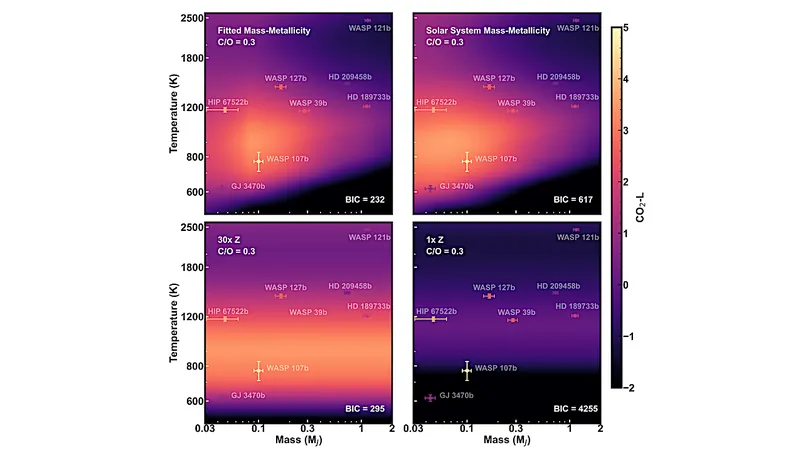
Groundbreaking Insights into Exoplanet Atmospheres Using JWST: What the Data Reveals!
2025-01-10
Author: John Tan
Introduction
The universe is a canvas painted with mysteries, and each new exoplanet discovered adds another brushstroke to our understanding of the cosmos. Thanks to the James Webb Space Telescope (JWST), scientists are making remarkable strides in characterizing the atmospheres surrounding these distant worlds. With each observation, we move closer to unveiling their secrets—patterns that might hold the key to understanding other planetary systems.
Analysis Framework
Recent research highlights a robust framework for analyzing exoplanet transmission spectroscopy in the infrared range of 3 to 5 micrometers. This study focuses on four crucial bands: the L band (2.9 – 3.7 µm), sulfur dioxide (SO2, 3.95 – 4.1 µm), carbon dioxide (CO2, 4.25 – 4.4 µm), and carbon monoxide (CO, 4.5 – 4.9 µm). These bands are vital as they encompass the major carbon, oxygen, nitrogen, and sulfur-bearing molecules prevalent in planetary atmospheres, including water (H2O), methane (CH4), ammonia (NH3), hydrogen sulfide (H2S), along with SO2, CO2, and CO.
Key Findings
Among the eight meticulously analyzed gas giant exoplanets, intriguing correlations emerged. A striking link between the SO2-L index and both the mass (r=-0.41±0.09) and temperature (r=-0.64±0.08) of the planets was observed. This suggests that sulfur dioxide is more likely to be present in low-mass planets (mass < 0.3 MJ) and cooler environments (temperature < 1200K).
Furthermore, both CO2 and CO exhibited a strong temperature dependency. Under the assumption of equilibrium chemistry and a stable thermal structure, the data point toward a preference for super-solar metallicity and lower carbon-to-oxygen (C/O) ratios (less than 0.7). Remarkably, a mass-metallicity correlation was favored rather than a uniform metallicity across the sample of eight gas giants.
Innovative Representation
To aid in the analysis, researchers have introduced a new diagram plotting SO2-L against CO2-L, akin to the color-magnitude diagrams used for stars and brown dwarfs. This innovative representation will enable scientists to visualize trends and relationships, providing a framework for future data assessments.
Normalization and Future Research
All the spectra included in this groundbreaking study are normalized according to their respective atmospheric scale heights, allowing for a clear comparison across different planets. Researchers are optimistic that these observations will not only be verified but also expanded upon through ongoing and future JWST missions, which will continue to shed light on the atmospheric dynamics of exoplanets.
Conclusion
As the journey through the cosmos continues, the knowledge gained from JWST’s explorations could eventually answer questions about the potential for life beyond Earth. Researchers emphasize the necessity of further observations to confirm these findings and enhance our understanding of planetary atmospheres.
In this unfolding story of the universe, stay tuned for the next chapter, as we use the JWST to untangle more mysteries that the stars and planets have to offer!
 Brasil (PT)
Brasil (PT)
 Canada (EN)
Canada (EN)
 Chile (ES)
Chile (ES)
 Česko (CS)
Česko (CS)
 대한민국 (KO)
대한민국 (KO)
 España (ES)
España (ES)
 France (FR)
France (FR)
 Hong Kong (EN)
Hong Kong (EN)
 Italia (IT)
Italia (IT)
 日本 (JA)
日本 (JA)
 Magyarország (HU)
Magyarország (HU)
 Norge (NO)
Norge (NO)
 Polska (PL)
Polska (PL)
 Schweiz (DE)
Schweiz (DE)
 Singapore (EN)
Singapore (EN)
 Sverige (SV)
Sverige (SV)
 Suomi (FI)
Suomi (FI)
 Türkiye (TR)
Türkiye (TR)
 الإمارات العربية المتحدة (AR)
الإمارات العربية المتحدة (AR)